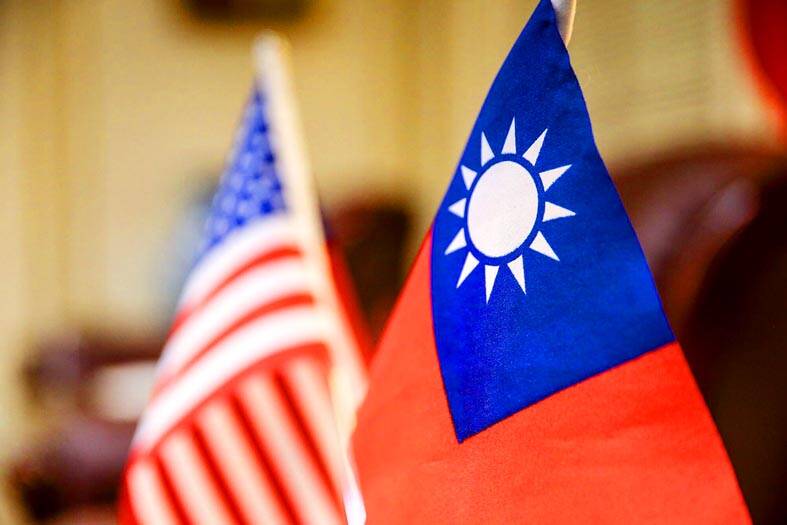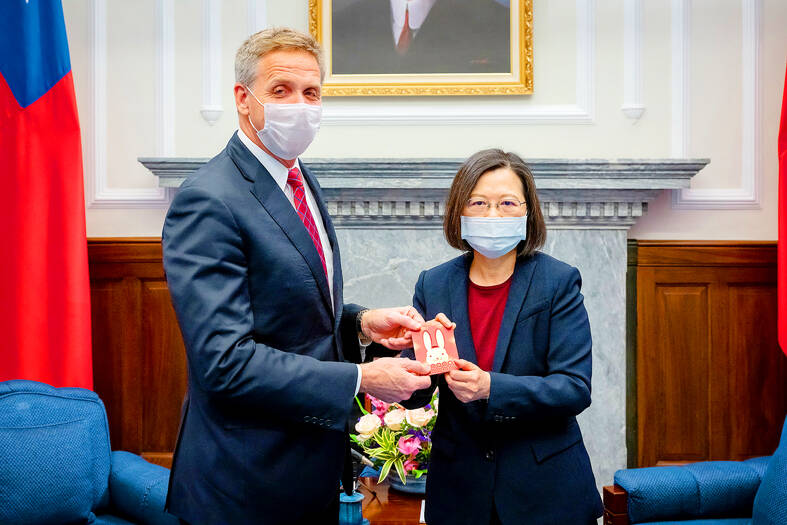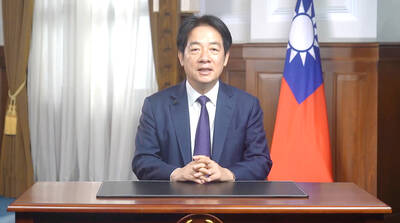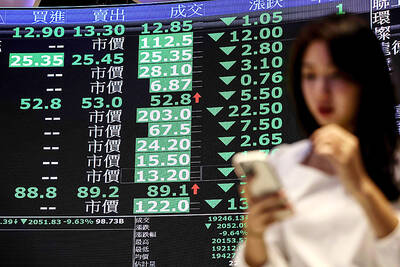If influence in the Indo-Pacific region is one of the US’ core interests, then Taiwan serves as a cornerstone of US economic and security influence in the region, former US Indo-Pacific Command commander admiral Phillip Davidson said on Thursday.
“China’s ... strategy is to supplant the US leadership role in the international order ... and they’ve long said ... that they intend to do that by 2050,” Davidson told the National Review Institute’s Ideas Summit in Washington.
Davidson said he had previously told US Senate hearings on China’s military activities and possible threats in the Indo-Pacific region that a Chinese invasion of Taiwan could happen within the next 10 years, or even the next six years.

Photo: Cheng I-hwa, Bloomberg
That timeline should not be taken as a definitive plan for China to attack, but rather a timeframe in which China would use economic, diplomatic and military means to weaken the US, and create the impression that China is on the rise while the US is in decline, Davidson said.
China has clearly stated its intent to prioritize “internal” security issues, which includes Taiwan, Davidson said, adding that in light of such statements, the US needs stronger deterrents against China.
Taiwan is a core interest for China, and the US’ regional allies are accustomed to gauging US policy reliability based on the Taiwan Relations Act and long-standing US-Taiwan relations, Davidson said.

Photo: EPA-EFE / Makoto Lin / Presidential Office
While the US should reinforce its relations with partners and allies, which includes assisting Taiwan, Taiwan must invest in strengthening its defenses as well, Davidson said.
Elbridge Colby, nominee for US undersecretary of defense for policy, on March 5 said that Taiwan’s defense spending was insufficient and should come closer to 10 percent of GDP.
Davidson also said that in addition to developing asymmetrical combat capabilities, Taiwan’s traditional combat capabilities also need work, citing how Taiwan needs more traditional weapons platforms, including planes, ships and submarines, to counteract Chinese People’s Liberation Army (PLA) harassment.
The PLA frequently sends its jets and planes into the Taiwanese air defense identification zone, flies past the median line of the Taiwan Strait and sails ships around Taiwan, he said.
Asked what were the possible results of Taiwan becoming a part of China, Davidson speculated that Japan and South Korea would contemplate developing their own nuclear umbrella to safeguard their regional interests, challenging the US stance on nuclear proliferation and possibly destabilizing the US-led Asia-Pacific security architecture.

ACTION PLAN: Taiwan would expand procurement from the US and encourage more companies to invest in the US to deepen bilateral cooperation, Lai said The government would not impose reciprocal tariffs in retaliation against US levies, President William Lai (賴清德) said yesterday, as he announced five strategies to address the issue, including pledging to increase Taiwanese companies’ investments in the US. Lai has in the past few days met with administrative and national security officials, as well as representatives from various industries, to explore countermeasures after US President Donald Trump on Wednesday last week announced a 32 percent duty on Taiwanese imports. In a video released yesterday evening, Lai said that Taiwan would not retaliate against the US with higher tariffs and Taiwanese companies’ commitments to

Intelligence agents have recorded 510,000 instances of “controversial information” being spread online by the Chinese Communist Party (CCP) so far this year, the National Security Bureau (NSB) said in a report yesterday, as it warned of artificial intelligence (AI) being employed to generate destabilizing misinformation. The bureau submitted a written report to the Legislative Yuan in preparation for National Security Bureau Director-General Tsai Ming-yen’s (蔡明彥) appearance before the Foreign Affairs and National Defense Committee today. The CCP has been using cognitive warfare to divide Taiwanese society by commenting on controversial issues such as Taiwan Semiconductor Manufacturing Co’s (TSMC, 台積電) investments in the

HELPING HAND: The steering committee of the National Stabilization Fund is expected to hold a meeting to discuss how and when to utilize the fund to help buffer the sell-off The TAIEX plunged 2,065.87 points, or 9.7 percent, to close at 19,232.35 yesterday, the highest single-day percentage loss on record, as investors braced for US President Donald Trump’s tariffs after an extended holiday weekend. Amid the pessimistic atmosphere, 945 listed companies led by large-cap stocks — including Taiwan Semiconductor Manufacturing Co (TSMC, 台積電), Hon Hai Precision Industry Co (鴻海精密) and Largan Precision Co (大立光) — fell by the daily maximum of 10 percent at the close, Taiwan Stock Exchange data showed. The number of listed companies ending limit-down set a new record, the exchange said. The TAIEX plunged by daily maxiumu in just

‘COMPREHENSIVE PLAN’: Lin Chia-lung said that the government was ready to talk about a variety of issues, including investment in and purchases from the US The National Stabilization Fund (NSF) yesterday announced that it would step in to staunch stock market losses for the ninth time in the nation’s history. An NSF board meeting, originally scheduled for Monday next week, was moved to yesterday after stocks plummeted in the wake of US President Donald Trump’s announcement of 32 percent tariffs on Taiwan on Wednesday last week. Board members voted to support the stock market with the NT$500 billion (US$15.15 billion) fund, with injections of funds to begin as soon as today. The NSF in 2000 injected NT$120 billion to stabilize stocks, the most ever. The lowest amount it